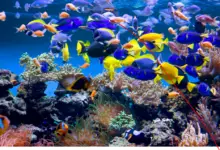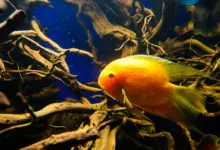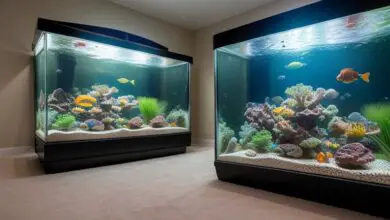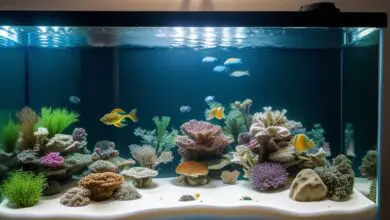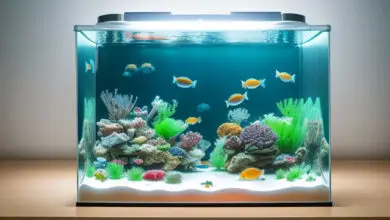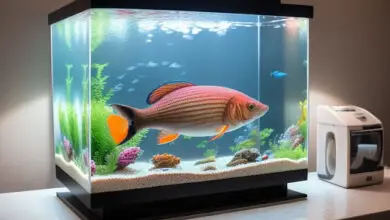How to Reduce Your Aquarium’s Carbon Footprint

From electricity usage to disposable plastic filters, aquariums have a carbon footprint. As an aquarium owner, you may be wondering how you can reduce your tank’s impact on the planet. The good news is that with some simple changes, you can dramatically lower your aquarium’s carbon emissions and energy consumption.
I want us to learn some easy, eco-friendly ways to transform your aquarium into a sustainable ecosystem. You’ll learn about energy-efficient lighting options, sustainable filtration systems, responsible water usage, carbon-neutral substrates, and much more. We’ve also included answers to some frequently asked questions on going green with your home aquarium.
Follow along for tips to create a healthy, thriving habitat for your fish while also caring for the planet. Small changes can make a big difference – let’s dive in!
Energy-Efficient LED Aquarium Lighting
One of the main ways your tank consumes electricity is through lighting. Traditional fluorescent tubes tend to be energy hogs, putting unnecessary strain on your electric bill and the environment. Luckily, LED aquarium lights provide the same full spectrum lighting that fish and plants need while using a fraction of the energy.
LED lighting for aquariums has advanced tremendously in recent years. The bulbs last much longer than traditional lighting, often for over 50,000 hours of use. This saves you money by avoiding frequent bulb replacements. And because LEDs give off very little heat, they won’t dangerously raise water temperatures.
When shopping for an LED aquarium light, look for one made specifically for planted tanks if you want to keep live plants. Be sure to get the right balance of brightness and full spectrum light for the size of your tank. Programmable lights allow you to set custom cycles that mimic natural daylight patterns to support fish and plant health. Smart lighting systems can automatically ramp brightness up and down, saving even more energy.
Making the switch to LED is one of the best ecological decisions you can make for your aquarium. Next up, let’s talk about sustainable filtration methods.
Sustainable Aquarium Filtration Systems
Filtration is what keeps aquarium water crystal clear by removing waste, debris, and harmful chemicals. Unfortunately most disposable filter cartridges end up in landfills, contributing to plastic pollution.
To avoid throwing out and replacing filter media every month, opt for a reusable filtration system. Here are some eco-friendly aquarium filter options:
Sponge Filters: This simple, customizable filtration uses low energy air pumps to pull water through porous sponges. Sponges provide abundant surface area for beneficial bacteria to flourish. Rinse and reuse sponges as needed.
Canister Filters: Canister setups feature large media baskets to fill with sustainable materials like ceramic rings, bio balls, crushed lava rock, and more. Only pipes require occasional replacing.
Fluidized Bed Filters: These systems use sand, gravel or other media kept in perpetual suspension to remove waste. A great spot for bacteria with minimal plastic involved.
** Wet/Dry Trickle Filters**: Trickle systems oxygenate water as it flows over bio balls or lava rock media to enhance beneficial bacteria growth. Low plastic waste.
No matter what system you choose, look for models with flow control valves and energy efficient pumps (not oversized for your tank). Maintain clean filters, tubing and pipes to optimize performance and lifespan.
Responsible Water Usage and Conservation
Filling, replacing and topping off water in aquariums represents a major household use of water. Typical aquarium guidelines suggest changing 10-25% of a tank’s water weekly. But for the eco-conscious aquarist, what’s the truly sustainable water change regimen?
Test First, Change Later
Instead of defaulting to weekly water swaps, invest in water quality testing kits. Check levels of ammonia, nitrites/nitrates and pH once a month. Then only change water if toxicity creeps up or pH swings off kilter between 7-8. This prevents needlessly dumping out clean water.
Use Conditioners & Supplements When water changes are needed, products like ammonia neutralizers can instantly detoxify without huge water changes. Reducing water flow to match filtration capacity also lengthens time between changes. And consider air/water stones or live plants to oxygenate and absorb nitrates, cutting change frequency.
Find Efficient Water Sources Tap water requires energy to be treated, pressurized and piped to your home. An eco-friendly way to source aquarium water is rain collection barrels. Or use discarded water from cooking vegetables, pasta, etc which is nutrient rich. Dechlorinate and temperature match before adding.
Cut Evaporation Loss Open topped aquariums can lose a quarter inch of water daily to evaporation. This strains local water reserves to keep topping it off. Seal tanks tightly with glass tops to drastically slow water loss. Also keep aquarium lights and room temps moderate – heat accelerates evaporation.
Saving water around aquarium use positively impacts the earth and your wallet! Now let’s explore maintaining tanks through an environmental lens.
Practicing Eco-Friendly Fishkeeping
Caring for aquarium fish plays a large role in your tank’s environmental footprint. From treating illnesses to cleaning algae, how sustainable are your fishkeeping habits? Here are earth-friendly ways to look after fish health and habitat upkeep:
Feed Responsibly Overfeeding fish causes water quality crashes. Stick to aquarium feeding guides and only offer what fish finish within 2-3 minutes, 1-2 times daily. Soak flakes first to reduce waste. Grow supplemental algae, microgreens or insects for protein and enrichment.
Prevent Problems Boost fish immunity and reduce disease risk through stellar water quality, reduced stress and optimal nutrition. Use hospital/quarantine tanks for new arrivals. This avoids dosing entire systems with meds. Target treatments whenever possible.
Control Algae Naturally Skip chemical algaecides which harm essential bacteria and contribute toxins. Instead, use algae eating crew (plecos, snails), reduce lighting periods, remove phosphates and manually remove what you can each week during changes.
Clean Green Clean intake tubes/decor during water changes, not midweek. Use soft aquarium vacuums over gravel washing. Wipe glass with reusable cloths versus disposable scrubbies. Skip filter cartridge replacements by swishing/squeezing gunk out when clogged, then returning to filter baskets.
Follow these tips and your tank inhabitants can thrive in good health with minimal environmental impact! Up next we’ll cover sustainable substrates.
Carbon-Neutral Substrate Choices
Choosing the correct aquarium gravel, sand or other tank substrate encourages healthy plant growth and water parameters. But did you know some substrates give off more greenhouse gasses than others? Stay away from soil based flora options which create methane gas as they break down underwater. Instead opt for these eco-friendly alternatives:
Eco-Friendly Substrate Options
Inert Gravels – Whether smooth pebbles or more varied aggregates, inert gravel materials like quartz, granite and river rock won’t alter water chemistry. Use smaller gravel for heavily planted tanks to prevent anaerobic gas pockets.
Crushed Coral/Aragonite – These calcium carbonate substrates slowly release beneficial calcium, carbonates and magnesium to stabilize pH around 8.0-8.3 without CO2 emissions. Great for African Rift Lake cichlid setups.
Coconut Husk – Also called coco coir, this base buffers pH to neutral and provides cation exchange capacity for plant roots. Derived from a renewable coconut industry waste product. Rinse well before use.
Volcanic Stone – Porous lava rock, petrified wood and ceramics like TerraCotta pot shards create excellent refuge for beneficial bacteria critical to nutrient processing. Won’t change water parameters.
Sand & Fine Gravels – Though not very porous themselves, play sands and smooth substrates under about 2-3mm diameter allow anaerobic gas pockets to form if deep enough. Use in combination with other materials.
Choosing sustainable substrates can positively impact your aquarium ecosystem as well as environmental health on a global scale. Keep reading for additional ways to green up your tank maintenance routine.
Green Approaches to Aquarium Maintenance
Regular aquarium maintenance like scrubbing algae, changing water and cleaning filters helps provide fish, plants and invertebrates a safe, healthy habitat. But what’s the most eco-friendly way to care for your tank? Implement these sustainable cleaning strategies:
Set a Schedule – Establish specific days or dates each month to test water, prune plants, wipe glass and handle targeted spot cleanings. Grouping tasks together on one day cuts down on how frequently you interact with the tank, saving energy and resources.
Use Natural Tools – Skip plastic scrub pads and magical chemical potions to address aquarium cleaning tasks. Reach for wooden plant clips, stainless steel algae scrubbers and soft cloth diapers to wipe away debris and brush algae during routine upkeep.
Improve Filtration Flow – Clogged, dirty intake tubes and filters force pumps to work overtime reducing component lifespan. Keep your filtration system operating at peak flow by regularly rinsing filter media and using pipe cleaners to clear buildup blocking water flow during cleaning sessions.
Enlist Clean Up Crews – Recruit algae eating snails like nerites and shrimp or reality harmless suckerfish (otocinclus, plecos) to lighten your cleaning load. Provide supplemental vegetables and algae wafers to keep crew members well-fed so they continue gobbling up debris.
Adopting a sustainable aquarium maintenance routine saves energy, preserves gear longevity and provides stability for aquatic life. Next we’ll explore ways to curb plastic pollution and waste from aquarium ownership.
Minimizing Plastic & Waste in Aquariums
As an aquarium hobbyist, being aware of your plastic usage and minimizing disposable waste protects our oceans and landfills. Here are impactful ways to reduce your aquarium’s environmental footprint:
Avoid Replaceable Filter Cartridges – Disposable filter inserts top the list of plastic pollution culprits in fishkeeping. Favor reusable sponges, bio-media and mesh bags instead to eliminate this waste stream entirely.
Seek Sustainable Foods – Conventionally farmed fish flakes and freeze dried foods leave a substantial carbon footprint plus generate lots of plastic packaging trash. Opt for eco-conscious aquarium foods using renewable ingredients and minimal, recyclable materials.
Embrace Natural Decor – Plastic plants and ornaments leach chemicals and end up discarded eventually. For safer habitats and less waste, decorate with durable slate and stone arrangements, mineral formations, real driftwood and live plants instead.
Reduce Test Strip Use – Test strips are notoriously inaccurate and most contain nasty heavy metals. Digital testers last for years, save money long term and keep thousands of test strips out of landfills throughout their usable lifespan.
Reuse Where Possible – Before throwing out old equipment, repair or repurpose items first. Donate functioning gear to fellow hobbyists and schools. Upcycle cracked tanks or broken ornaments into mini pond planters or terrariums.
With some thoughtful shifts in products and habits, aquarium enthusiasts can nurture underwater ecosystems while also protecting the planet’s intricate web of life. Now let’s wrap up with answers to common eco-friendly aquarium questions.
Frequently Asked Questions
Can Using Energy-Efficient Lighting in My Aquarium Have Any Negative Effects on My Fish or Plants?
When chosen correctly for the size of your tank, energy efficient LED lighting poses no risks to aquatic life. LEDs last much longer than other types of aquarium lighting while using a fraction of the electricity. Just be sure to select full spectrum LEDs rated specifically for freshwater plant and reef tanks to provide everything your underwater community needs to thrive.
How Can I Ensure That the Sustainable Filtration System I Choose Will Effectively Maintain Water Quality in My Aquarium?
No matter what eco-friendly filtration system you opt for, ensure it’s properly sized for your aquarium’s water volume and stocking level. Read reviews and talk to others using sustainable filters you’re considering before purchasing. When first setting up sustainable filtration, test water parameters weekly to confirm everything remains stable. Be prepared to tweak pump flow rates or filtration media if ammonia/nitrates spike initially.
Are There Any Specific Eco-Friendly Practices for Water Consumption That Can Benefit Both My Aquarium and the Environment?
Using alternative water sources like rain collection barrels or reclaimed cooking water helps conserve environmental reserves. Just be sure to use water conditioners to remove chlorine or chloramines. Matching old and new water temperature before adding prevents shocking fish. Limit water loss from evaporation by keeping tanks covered. And supplementing the filter with live plants or algae can lengthen the time between water changes.
What Are Some Examples of Carbon-Neutral Substrate Choices and How Do They Compare to Traditional Substrates?
Instead of standard aquarium gravel or chemical buffering substrates, carbon-friendly alternatives include crushed coral, petrified wood, lava rock shards or coconut husk bedding. These renewable materials won’t break down and emit gases like soil based plant substrates can underwater. Carbon-neutral substrates also encourage beneficial bacteria growth. Compared to plain gravels, these provide more surface area and pH buffering capacity too.
What Are Some Alternative Approaches to Aquarium Maintenance That Can Reduce Waste and Plastic Usage?
Simple changes like using reusable cloths and wooden tools for algae removal slashes disposable plastic waste. Setting a routine maintenance schedule also cuts down on filter media replacements. Feeding fish only what they can consume in a few minutes prevents wasted food and water fouling. And installing an efficient water filtration system with reusable media eliminates regularly throwing out dirty disposable filter cartridges.
Conclusion
Transforming your home aquarium into an eco-friendly habitat takes a little forethought but pays back manifold benefits. From saving on electricity expenses to reducing plastic waste, small upgrades add up to real environmental savings over years of fishkeeping. Plus sustainable aquarium practices modeled for children instill lifelong conservation values around responsible pet ownership.
We coveredquite a few easy green strategies in this blog including:
- Installing energy efficient LED full spectrum lighting
- Choosing reusable filtration systems
- Conserving water through selective changing
- Keeping fish naturally healthy to avoid meds
- Using carbon-neutral substrate materials
- Streamlining maintenance routines
- Cutting down on disposable plastics
What upgrades seem most feasible to implement for your aquarium after reading this post? Have you discovered any other innovative ways to reduce your tank’s carbon footprint? Share your ideas and experiences with us about making fishkeeping more sustainable for the future.

